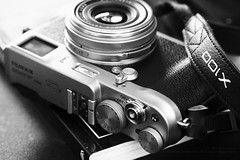Previously I was wondering if there was a camera renouveau. The highly anticipated Fuji FinePix X100 could be one of the contenders with its innovative viewfinder. The problem is that following the earthquake in Sendai, the Japanese production of cameras in Japan has suffered, making the X100 harder to find. This does not seem to stop the enthusiasm.
Nonetheless, people still start getting their hands on it. No later than last week I saw one at a local camera store, unfortunately no demo model. Here is a couple of recent reviews:
Steve Huff ask “Does it live up to the Hype?”. Steve Huff is a Leica M9 shooter but will compare the X100 to the Leica X1 which is must closer.
[…] those who want the X100 are looking for something fresh, new, exciting, small and classic. As I recently found out for myself, the X100 is all of that and more.
His perspective is from the photographer taking pictures, and the result. He answered the question positively.
DCResource with their usual format will go through all the usual details and review all the features in the camera. You can compare images between their other tests, and doing this between the X100 and the Olympus E-P1 is making me drool even more.
Their conclusion:
All things considered, the Fuji FinePix X100 is a very impressive fixed lens camera, and I imagine that they’ll sell a boatload of them, despite the price. It offers superb photo quality, good performance (in most respects), a rangefinder-style body with a one-of-a-kind viewfinder, and plenty of manual controls. The camera does have its issues, mostly related to buffer memory and the user interface, but for a first generation camera, Fuji has done a great job.
Previously, in case you missed these:
